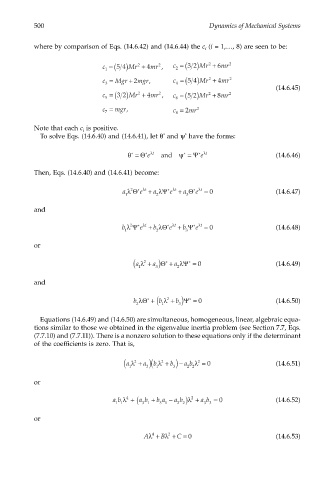Page 519 - Dynamics of Mechanical Systems
P. 519
0593_C14_fm Page 500 Tuesday, May 7, 2002 6:56 AM
500 Dynamics of Mechanical Systems
where by comparison of Eqs. (14.6.42) and (14.6.44) the c (i = 1,…, 8) are seen to be:
i
c = ( 54) Mr + 4 mr , c = ( 32) Mr + 6 mr 2
2
2
2
2
1
c = Mgr 2 mgr, c = ( 54) Mr + 4 mr 2
+
2
3 4
(14.6.45)
c = ( 32) Mr + 4 mr , c = ( 52) Mr + 8 mr 2
2
2
2
5
6
c = mgr, c = 2 mr 2
7
8
Note that each c is positive.
i
*
To solve Eqs. (14.6.40) and (14.6.41), let θ and ψ have the forms:
*
*
*
*
θ = Θ e λt and ψ = Ψ e λt (14.6.46)
*
Then, Eqs. (14.6.40) and (14.6.41) become:
t λ
t λ
t λ
a λ Θ * e + a λΨ * e + a Θ * e = 0 (14.6.47)
2
1 2 3
and
t λ
t λ
t λ
b λ Ψ * e + b λΘ * e + b Ψ * e = 0 (14.6.48)
2
1 2 3
or
( a λ + )Θ * + a λΨ * = 0 (14.6.49)
2
a
3
2
1
and
b λΘ + ( b λ + ) *
b Ψ =
2
*
2 1 3 0 (14.6.50)
Equations (14.6.49) and (14.6.50) are simultaneous, homogeneous, linear, algebraic equa-
tions similar to those we obtained in the eigenvalue inertia problem (see Section 7.7, Eqs.
(7.7.10) and (7.7.11)). There is a nonzero solution to these equations only if the determinant
of the coefficients is zero. That is,
( a λ + )( b λ + ) − a b λ = 0 (14.6.51)
2
2
2
b
a
2 2
3
3
1
1
or
a b λ + ( ab + b a − ab λ ) 2 + ab =
4
11 31 3 1 2 2 33 0 (14.6.52)
or
Aλ + Bλ + C = 0 (14.6.53)
4
2

